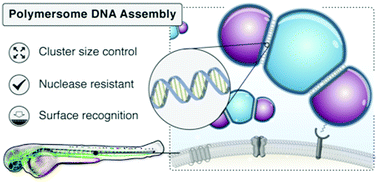DNA-directed arrangement of soft synthetic compartments and their behavior in vitro and in vivo†
Abstract
DNA has been widely used as a key tether to promote self-organization of super-assemblies with emergent properties. However, control of this process is still challenging for compartment assemblies and to date the resulting assemblies have unstable membranes precluding in vitro and in vivo testing. Here we present our approach to overcome these limitations, by manipulating molecular factors such as compartment membrane composition and DNA surface density, thereby controlling the size and stability of the resulting DNA-linked compartment clusters. The soft, flexible character of the polymer membrane and low number of ssDNA remaining exposed after cluster formation determine the interaction of these clusters with the cell surface. These clusters exhibit in vivo stability and lack of toxicity in a zebrafish model. To display the breadth of therapeutic applications attainable with our system, we encapsulated the medically established enzyme laccase within the inner compartment and demonstrated its activity within the clustered compartments. Most importantly, these clusters can interact selectively with different cell lines, opening a new strategy to modify and expand cellular functions by attaching such pre-organized soft DNA-mediated compartment clusters on cell surfaces for cell engineering or therapeutic applications.



 Please wait while we load your content...
Please wait while we load your content...